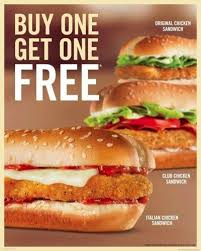Languange Styles In Advertisement
Advertisers use Text types or Genres that: Coax, Entice, Induce, Deceive, Beguile and Persuade
Here’s four ingredients of successful ads: attention,
interest, desire and action (AIDA).
- Attention: Eye-catching layout, striking features to make people take notice. Clear concise expression short sentences and paragraphs. Captivating Graphics. Spectacular Layout easy to grasp.
- Interest: to sustain interest, often targeted to a niche market.
- Desire: the ad will create or develop a need or desire for the product. (See below)
- Action:an urging for direct action with some incentives; gifts, limited time, special deals, Usually in the second person with an imperative tone.
Advertisers recognise that we all have fears, hopes,
anxieties, aspirations, insecurities and dreams and rather than satisfy
desires, not needs, they lull us into false illusions that these will be filled
by consumerism. They exploit our psyche by appeals to:
- Status – snob values: Top people read Spectrum, discerning people drink Baileys, discriminating tastes prefer King Island Cheese, the best homes… exclusive
- Fear of non-conformity: bad breath, B.O., pejoratives, old-fashioned, negative associations.
- Security – Get with the strength, a name you can trust, Est. 1870.
- Ease and Comfort - Relax, treat yourself, processed food, self indulgence.
- Authority - Doctors recommend, or horse trainers/dog trainers/racing car drivers or just famous people, athletes through either direct testimonial or by association linking the product with fame and prestige.
- Brand names: To establish these you must imbue them with epic qualities and have them branded into the psyches of your target (niche) audience.
- Symbol Manipulation: You invest objects with significance that transcend themselves through association: Though attractive, the links can be deceptive. Cigarettes to elegance, social acceptance, outdoor health scenes, Cars and sexy women, foods and heroic sporting achievements…..
- Impressive Layouts and Graphics with attention grabbing and subtle display and exploitation of colour.
Characteristics
of Persuasive language:
- Emotive language – coloured and biased language with affected and associated meanings: new, free, wanted, sensational
- Abstract words - beauty, delicious, satisfying, they invest their products with significance or symbolism beyond themselves; aristocratic elegance, sportsmanship, good health or sexual attractiveness.
- Catchy Phrases – language to arrest your attention; to lure you in, to seduce, to communicate instantly, briefly, concisely with impact.
- Poetic, Glamorised or Euphemistic Language – They ransack the language for words and phrases and plagiarise poetry unashamedly. They choose glossy, glamorous flowing language that lulls or hypnotises you, dulling your intellect. Sound effects: alliteration, assonance and rhyme and rhythm
- Imperative Mood - The language urges, orders or commands you to act in an assertive aggressive enterprising manner.
- Use of the Second Person - You are being addressed, targeted, made to feel special. You are induced to “treat/indulge yourself” because you deserve it – to arouse self-interest. They speak directly to the reader.
- Abuse of Language - Advertisers can be very dishonest in how they use language. Without resorting to outright lies, they attempt to make “gilt seem gold, the shoddy silk; to cheat us legally.”
- Frequent use of Adjectives - a predominance of superlatives; best, freshest, cleanest, brightest, biggest, most real, special, crisp wonderful.
- Repetition - easy to read, and help to fix the product in the receivers mind. Brand names are repeated ad nauseum as are catchy phrases and jingles.
- Humour – softens us up for the soft sell.



Komentar
Posting Komentar